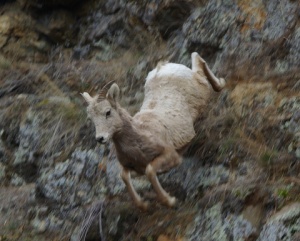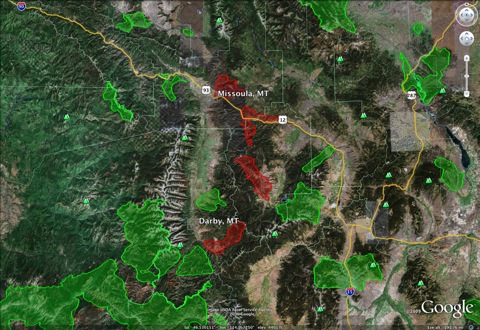Same pathogen found in bighorn and domestic sheep after contact was observed

Here are two stories outlining what happened this winter with the outbreaks of disease in bighorn sheep. It appears that there are likely two different causes for the outbreaks. In the East Fork Bitterroot it appears that bighorn contracted mycoplasma from a small herd of domestic sheep near Darby where the owner reported contact. The sheep were later tested for disease and the samples matched what was found in the bighorn sheep. To the north and east in the upper and lower Rock Creek herds and the Bonner herd it appears that something else is going on but, even though there are many domestic sheep in close proximity to these bighorn herds, no documented contact has been observed. That doesn’t say much though and doesn’t eliminate the likelihood that contact occurred. We’ve had reports on this blog of seeing domestic sheep in an area one day and bighorn sheep in the same area the next in this region.
It should be noted that the owner of the domestic sheep in the Sula, Mt. area has moved the sheep and is hoping that a new home can be found for them in an area that doesn’t have bighorn sheep.
Fortunately the outbreaks haven’t been as devastating as others on the basis of percentage. Still, the overall numbers of bighorn sheep lost is staggering and the effects of the outbreaks will likely impact lamb survival for years to come.
Pneumonia outbreak cut bighorn herds in half
By ROB CHANEY of the Missoulian
Biologist: Bitterroot herd survived pneumonia outbreak
By PERRY BACKUS Ravalli Republic

Comments
Yet the Woolgrower’s were so so sure that domestic sheep had zilch to do with recent die-offs. Maybe they’ll sue the non-UI of Lab that did the test for an Affront to Livestock Industry Mythology, to follow up on their suit against IDFG.
“We’ve had reports on this blog of seeing domestic sheep in an area one day and bighorn sheep in the same area the next in this region”
I must have missed this comment. Which area, Rock Creek? Bonner? When were these domestic sheep sighted? Who reported this?
Thanks.
When I went to Challis Elk Hunting last fall there were at least 30 Bighorn standing less than 40 yards across the road from a enclosed herd of sheep! They come down there and lick salt and minerals. It’s at the junction coming from Stanley just before you turn left to go to Challis. Has there been any infection in that area?
Ralph – I saw domestic sheep and bighorn eating back to back days last October in the same grass in the Rock Creek drainage.
I also had the pleasure of hiking amongst the herd up near the first campground. They were lounging about the forest in front of a nice set of cliffs. They loked healthy then and I did not see a single bighorn coughing.
For anyone interested here’s a pic I took of one of the Rock Creek bighorns October 2009 as I hiked around:
http://www.wilderness-sportsman.com/wsblog/wp-content/gallery/wilderness/ram-copy.jpg
I hope this one is still up there, doing OK.
Mike, can you be more specific as to where you saw the domestics and the bighorns overlapping? I spend a good deal of time in this area and I’ve never seen it, I’m curious as to where you were. Thanks.
Yes, Mike, it would be very helpful to know this.
Given that we’ve had four major outbreaks far from domestic sheep allotments on public land or large sheep producers, it seems like more needs to be done about pet domestic sheep and goats near public lands near bighorn populations. Is there something the legislature can do? Is there a major public outreach and education effort by wildlife managers and others during this window of opportunity provided by the current public interest associated with the die offs? With increased development adjacent to public land and on inholdings, and Plum Creek turning real estate company, and people with small numbers of sheep and goats for a variety of reasons, it seems like this is a growing threat.